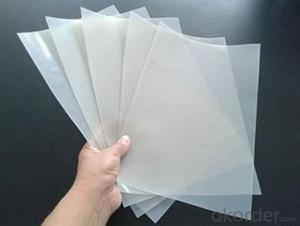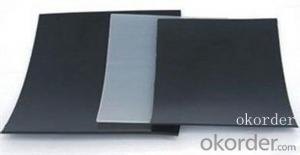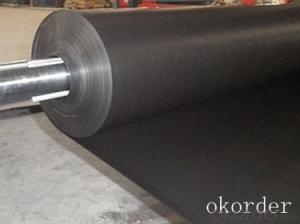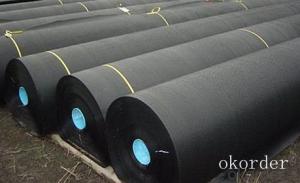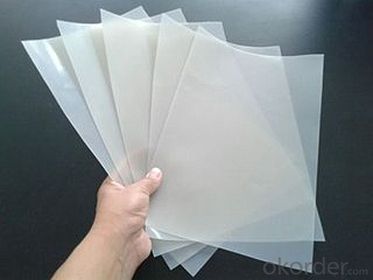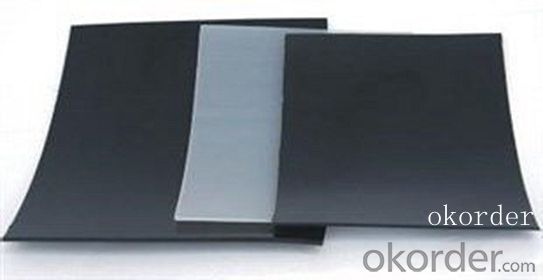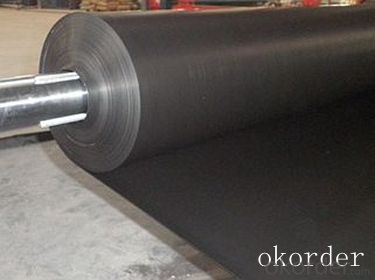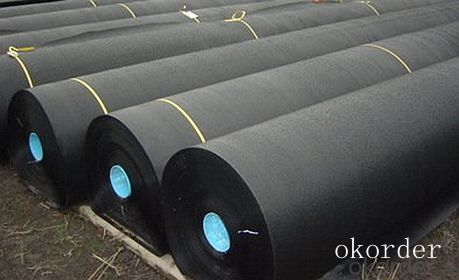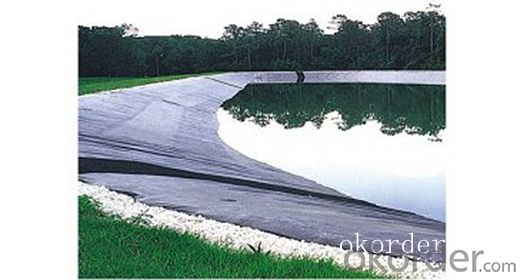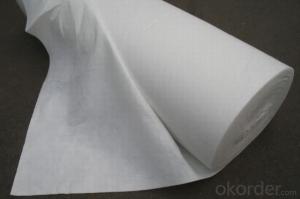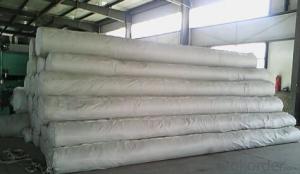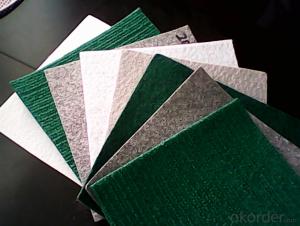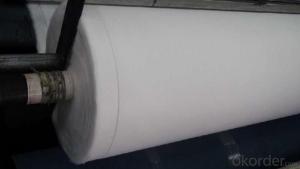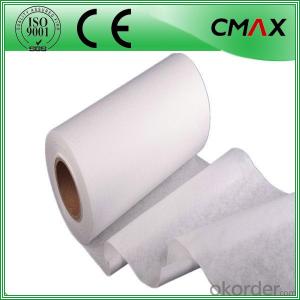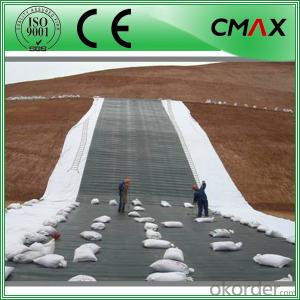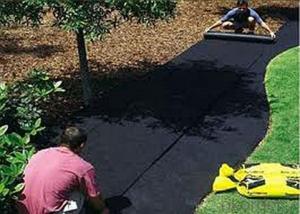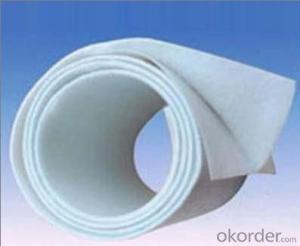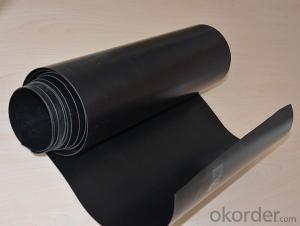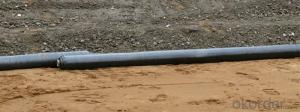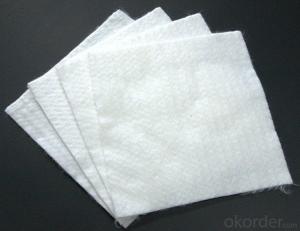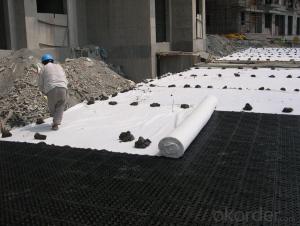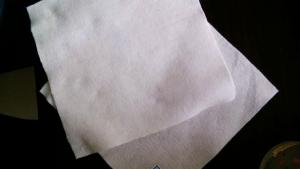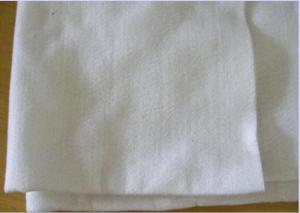Non Woven Geotextile Drainage Fabric Waterproofing Environmental Engineering HDPE Liner
- Loading Port:
- China main port
- Payment Terms:
- TT OR LC
- Min Order Qty:
- 1000 m²
- Supply Capability:
- 1000000 m²/month
OKorder Service Pledge
OKorder Financial Service
You Might Also Like
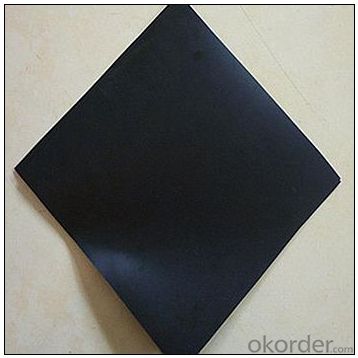
Product Introduction
Thickness:
1mm-3mm
Length:
50-200m as customers' request
Width:
4m~9m
Standard:
ISO, CE
Feature:
Chemical Resistant
Surface:
Textured Surface
Product name:
hdpe geomembrane manufacturers
Keyword:
hdpe geomembrane manufacturers
Application
1. high quality hdpe geomembrane use in agriculture
1. high quality hdpe geomembrane use in agriculture farm
3. high quality hdpe geomembrane use in shrimp ponds orLotus
Technical specifications of HDPE geomembrane:
a) Density ≥ 0.94g/m2
b) Tensile Strength ≥25Mpa
c) Elongation at Break ≥ 550%
d) Right-angled Tear ≥ 110N/mm
e.)Puncture Strength ≥ 550N
Applicable to river dams, tunnels, drainage bank seepage, metallurgy and chemical industry pollution prevention, construction, transportation, environmental protection works.
Our Service
1.On a regular basis or as per your request,we entrust national testing agencies to conduct quality inspections
2. Strictly in accordance with the ISO9001-2008 international quality system standard,we monitor and manage the whole process throughout production,quality testing,and measurement to ensure product quality
3. For quality-related construction delay or substandard construction(except for damage or losses due to customer’s responsibility or irresistible natural disasters),we have refunding,replacement,and repair services.We will respond to customers’ feedbacks on quality issues within 24 hours.
After-sales service
1.In order to provide customers with comprehensive technical support,we will provide technical and other related information upon request in a timely manner.
2.In required,we will appoint specialized technicians to the construction site to give technical trainings to construction people,and offer technical guidance throughout the whole construction process.
3.For damage due to shipment and delivery,after we receive the complaint,we will check the issure through provided pictures and videos.If our responsibility is confirmed,we wil offer free replacement.
4.When the construction is completed,as your request,our technical staff may participate in the final acceptance.
FAQ:
Q: What kind of payments does jenor support?
A: T/T, L/C, Cash are accepted.
Q: Do you charge for the samples?
A: Accordeing to our company policy, the samples are free, we only charge the freight fee. And we will return the freight fee during the next order.
Q: Can you produce according to customers' design?
A: Sure, we are professional manufacturer, OEM and ODM are both welcome.
Q: Do you have other products?
A: Yes, please check the pictures:
- Q: How do geotextiles affect soil erosion rates?
- Geotextiles can significantly reduce soil erosion rates. They act as a protective barrier that stabilizes the soil and prevents it from being washed away by water or blown away by wind. The geotextile fabric allows water to pass through while trapping sediment, thus promoting filtration and preventing erosion. Additionally, geotextiles can enhance vegetation growth by providing a favorable environment for plant establishment, further reducing soil erosion rates.
- Q: What are the different types of geotextile seams?
- There are three main types of geotextile seams: butt seams, sewn seams, and heat-sealed seams. Butt seams involve overlapping two geotextile panels and securing them with an adhesive or by heat bonding. Sewn seams involve stitching two panels together using a sewing machine and a high-strength thread. Heat-sealed seams are created by applying heat and pressure to melt the geotextile panels together, creating a strong and durable seam.
- Q: Where is the geotextile in the municipal works?
- Conservation, consideration, there is more green and more Chinese geotextile material manufacturers
- Q: What are the factors to consider when selecting geotextiles for a project?
- Some factors to consider when selecting geotextiles for a project include the required strength and durability of the material, the desired permeability for water flow, the appropriate weight or thickness for the specific application, the compatibility with the soil or aggregate materials, the resistance to UV degradation, and the cost-effectiveness of the product. Additionally, factors such as installation and maintenance requirements, as well as any specific project constraints or regulations, should also be taken into account when making a selection.
- Q: How do geotextiles help with soil separation in railway ballast systems?
- Geotextiles help with soil separation in railway ballast systems by preventing the mixing of different layers and ensuring the stability of the ballast. They act as a barrier between the ballast and subgrade, preventing the migration of fines from the subgrade into the ballast layer. This separation helps maintain the structural integrity of the railway track, reducing the risk of settlement and track deformations. Geotextiles also enhance drainage by allowing water to flow freely through the ballast layer, preventing waterlogging and maintaining the overall stability of the track.
- Q: Can geotextiles be used in temporary erosion control applications?
- Yes, geotextiles can be used in temporary erosion control applications. They are often used to stabilize soil and prevent erosion in construction sites, temporary roadways, and other areas where erosion control is needed temporarily. Geotextiles can effectively prevent soil erosion by providing a barrier that holds soil particles in place while allowing water to pass through.
- Q: What are the different manufacturing methods for geotextiles?
- There are several manufacturing methods for geotextiles, including needle punching, heat bonding, weaving, and knitting.
- Q: Are geotextiles resistant to puncture?
- Yes, geotextiles are generally resistant to puncture. They are designed to be durable and strong, offering protection against punctures caused by sharp objects or external forces.
- Q: 1 square of non-woven geotextiles how many tons
- Do you ask how many grams / square of non-woven geotextiles how much a ton? At present, the price of geotextile is subject to fluctuations in the impact of raw materials, the specific price needs to be priced seven days before the purchase. Geotextile manufacturers in the Swiss Zhang Ming Chao answer for you.
- Q: How are geotextiles affected by mechanical stress?
- Geotextiles are significantly affected by mechanical stress as they undergo deformation and potential damage due to external forces or loads. The stress can cause the geotextile to stretch, tear, or even rupture, affecting its overall performance and functionality. Therefore, it is essential to consider the mechanical stress factors when designing or implementing geotextile applications to ensure their long-term durability and effectiveness.
Send your message to us
Non Woven Geotextile Drainage Fabric Waterproofing Environmental Engineering HDPE Liner
- Loading Port:
- China main port
- Payment Terms:
- TT OR LC
- Min Order Qty:
- 1000 m²
- Supply Capability:
- 1000000 m²/month
OKorder Service Pledge
OKorder Financial Service
Similar products
Hot products
Hot Searches
Related keywords
